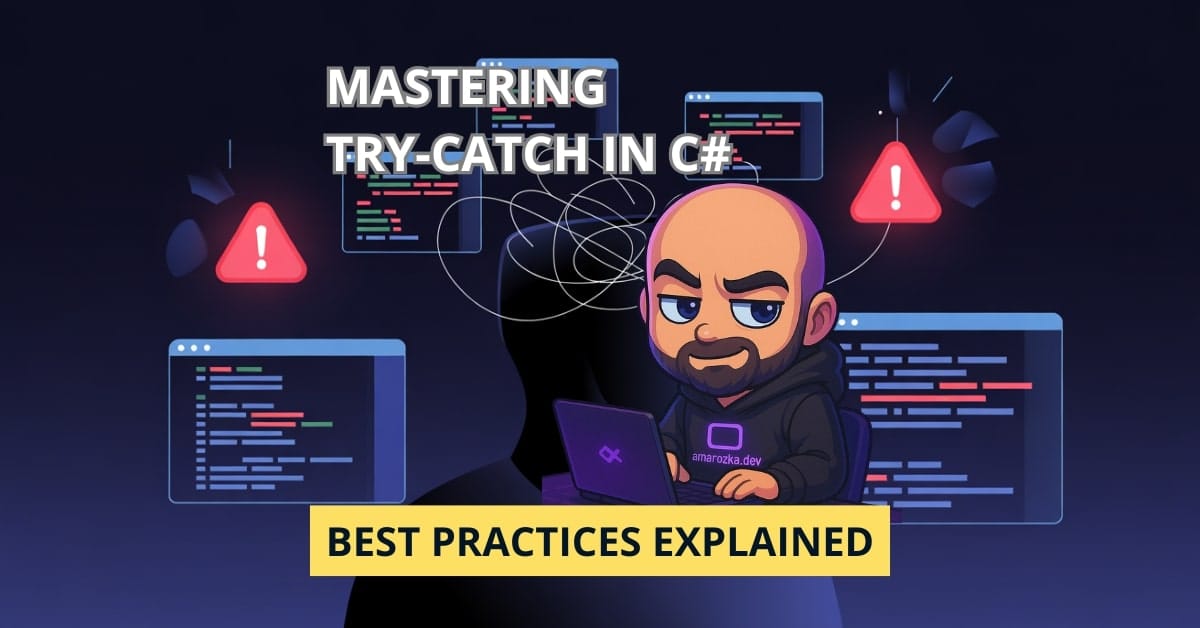Are you really using try-catch blocks effectively, or are they silently sabotaging your code?
Exception handling in C# isn’t just about wrapping code in try and catching everything with catch (Exception ex). Poorly placed try-catch blocks can obscure bugs, damage performance, or make your codebase harder to maintain. Let’s walk through what try-catch is, how it works, and the best practices that make a real difference in production code.
What is try-catch in C#?
The try-catch statement is C#’s built-in mechanism for handling runtime exceptions:
try
{
// Code that may throw an exception
int result = 10 / int.Parse("0");
}
catch (DivideByZeroException ex)
{
Console.WriteLine($"Cannot divide by zero: {ex.Message}");
}How it works:
- The
tryblock contains code that might throw an exception. - If an exception is thrown, execution jumps to the appropriate
catchblock. - If no exception occurs,
catchblocks are skipped.
This mechanism is essential when dealing with unpredictable operations like file access, user input, or network calls.
Catching Specific Exceptions First
Too many developers write this:
catch (Exception ex)
{
Console.WriteLine(ex.Message);
}Instead, catch the specific exception you’re expecting:
catch (FileNotFoundException ex)
{
Console.WriteLine("The file was not found.");
}
catch (IOException ex)
{
Console.WriteLine("A general IO error occurred.");
}Why?
- It helps debugging: You know exactly what failed.
- Prevents masking other bugs.
- Avoids swallowing unexpected exceptions.
Avoid Empty Catch Blocks
catch {}This is a code crime unless you’re intentionally suppressing noise (and you should document that).
Always log or handle:
catch (Exception ex)
{
Logger.Log(ex); // Use your logging system
throw; // or rethrow if not handled here
}Rethrowing Exceptions Correctly
Wrong:
catch (Exception ex)
{
throw ex; // NOPE
}Right:
catch (Exception ex)
{
throw; // Preserves the original stack trace
}Losing the original stack trace makes debugging much harder.
Don’t Use Try-Catch for Control Flow
This is a big anti-pattern:
try
{
var number = int.Parse("abc");
}
catch
{
number = 0;
}Use TryParse instead:
if (!int.TryParse("abc", out int number))
{
number = 0;
}Why?
- Avoids the performance cost of exceptions.
- Makes intent clearer.
Creating Custom Exceptions
Sometimes, built-in exception types aren’t enough to convey what really went wrong. That’s when you define your own:
public class InvalidUserInputException : Exception
{
public InvalidUserInputException(string message) : base(message) {}
public InvalidUserInputException(string message, Exception inner) : base(message, inner) {}
}Usage:
if (userInput == null)
{
throw new InvalidUserInputException("Input cannot be null.");
}Benefits:
- Adds semantic clarity to your code.
- Makes exception handling more granular.
- Encourages better documentation and debugging.
Just remember: don’t create custom exceptions unless they add value beyond existing types.
Finally: Always Clean Up
Use finally for cleanup actions:
FileStream stream = null;
try
{
stream = File.Open("data.txt", FileMode.Open);
// Process the file
}
catch (IOException ex)
{
Console.WriteLine("File error: " + ex.Message);
}
finally
{
stream?.Dispose(); // Cleanup guaranteed
}Bonus: Use “using” Instead of try-finally
The using statement is syntactic sugar for try-finally with Dispose:
using (var stream = File.Open("data.txt", FileMode.Open))
{
// Work with stream
}Cleaner and safer.
FAQ: Common Exception Handling Questions
Yes, for logging and graceful shutdowns. But only log, don’t try to recover from everything.
Use try-catch inside async methods. Unhandled exceptions in async code bubble up like regular ones.
Not if you use throw; (not throw ex). Don’t log the same exception multiple times though.
Conclusion: Handle Exceptions Like a Pro
The real power of try-catch lies in knowing when not to use it.
- Be specific.
- Don’t swallow exceptions.
- Avoid using it for flow control.
- Always clean up resources.
Next time you write a catch block, ask yourself: “Would this help me debug this issue 6 months from now?”
If the answer is no – rethink your exception strategy.
Want to level up your .NET debugging skills? Try refactoring one of your recent try-catch blocks using these tips and see how much clearer your code becomes. Share your results in the comments or with your team!
